
You can use this sample
FREE ESSAY for inspiration





Overview of Brazil as a Developing Country
The purpose of the paper is to look into various trends and patterns that are prevalent in Brazil as a developing nation. The major aspect that the paper covers includes an in-depth consideration of social and economic indicators that show the trend of the countrys economic performance on aspects such as gross domestic products and inflation rate that has been affecting the rate of unemployment among other things. Social indicators that the paper aims to consider include measures relating to education, ahealth, and poverty, which form the countrys major challenges. The paper further intends to discuss the countrys global economic integration with a major focus on the export that the country undertakes. Success of a country in the global market mainly depends on the level of its success in export and import of commodities. Other aspects that the paper will focus on are the relationship of Brazil with major international organizations such as the IMF and the WTO and social problems that the country faces in its development process.
Get a price quote
World sociology has often been concerned with explaining the relationship between and existence of economic or social inequalities between different regions and countries of the world. A given country is therefore described by sociologists as underdeveloped when it lags behind other countries in such sectors as education, healthcare, standard of living, industrialization, life expectancy, and other cultural and technological norms (Kay, 2011). In turn, a country is said to be developed when it has achieved certain economic and industrialization performance levels. Developed countries are often characterized by a growing gross domestic product, stable economy, and reasonable per capita income (Kay, 2011). The research project paper will, therefore, focus on Brazil as an underdeveloped country and try to give an explanation to some of the countrys trends and patterns relating to its development in the last five years. Some of the aspects that the paper will cover while trying to undertake the task include a comprehensive look at the countrys socio-economic indicators, its global market integration, relationship with major world organizations, and social problems that the country faces.






Brazil is one of the most influential countries in South America. The country has a huge population amounting to 204,259,812 people in total as of 2015, which is translated into a population growth rate of 0.77% per year (Bresser-Pereira, 2015). Sao Paulo is the biggest city in Brazil with the population of 15.3 million people and is closely followed by Rio de Janeiro with the population of 10.2 million, while Belo Horizonte is the third largest city with the population of 3.1 million. The table below shows the growth trend in the last five years.
Table 1
| Country | 2011 | 2012 | 2013 | 2014 | 2015 |
| Brazil | 203,429,800 | 199,321,400 | 201,009,600 | 202,656,800 | 204,259,812 |
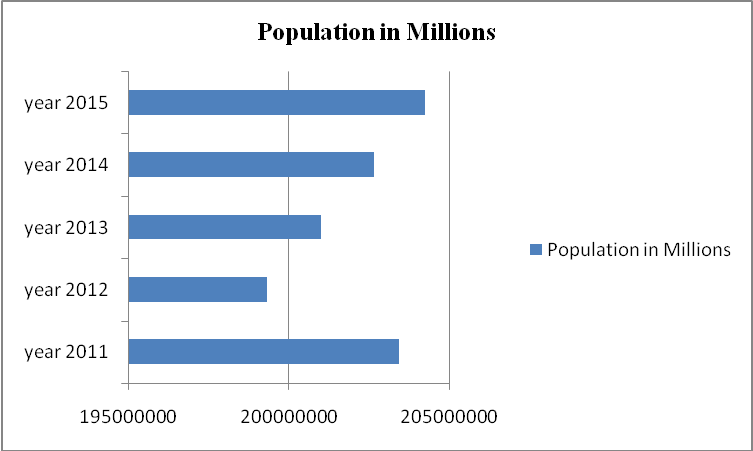
In the earlier years of establishment, the country underwent over a half century of military and populist government until in 1985 the military ceded power to the civilian rule. Since then, the country has strived towards industrial and agricultural growth and interior development. Through exploitation of the countrys vast natural resources and availability of a large labor force, the country has emerged as one of the regional leaders in South America. Brazil is currently ranked as the fifth largest country in the whole world in terms of coverage area and is classified as a developing nation and one of the rising economic powers in the world (Bresser-Pereira, 2015). However, the country still faces pressing problems in terms of crime, high-income inequality, corruption, and rising unemployment.
The country now witnesses a constant increase in the development of new technologies. For example, the country has been able to find a solution to the petroleum crisis that nations all over the world faced between 1973 and 1980 .The solution was through being the only country that managed to switch successfully from the commonly used petroleum as a source of energy to a more suitable renewable source of energy that was used as fuel for automobiles. Over half of Brazilian automobiles currently run on alcohol that is extracted from sugarcane and does not depend on petroleum fuel (Trading Economics, 2016).
In terms of tourism, the country is one of the countries whose tourism sector has been identified globally as having the potential to be developed. The country has been improving its media and public relations to attract more tourists to the country. The other strategy used by Brazil is to offer affordable air tickets to the country through various airlines (Trading Economics, 2016). The geographical weather is favorable in Brazil and the country is not prone to natural calamities such as earthquakes, tornados, and snow.
In terms of politics, the country has been slowly emerging as one of new global democracies. This success has been achieved through a democratic election of a president through the Electoral College. However, the promulgation of a new constitution has ensured that any election after that will be conducted through a popular vote used for electing leaders. Furthermore, the country has a good relationship with other neighboring countries, thereby contributing to fostering of the global peace.
Save 25%
Make your first order with 15% discount (with the code "best15") and get 10% OFF MORE for ALL orders by receiving 300 words/page instead of 275 words/page
The countrys AIDS program has become the most effective model adopted by other developing countries. The model has been successful in stabilizing HIV infection rate and has seen a decrease in AIDS-related deaths over the years (Bresser-Pereira, 2015). The country has further been successful in bypassing major global drug firms to produce generic and cheaper AIDS medicines. Finally, Brazil is one of the countries revered for its prowess in football and has been successful in major football competitions around the world.
Socio-Economic Indicators
Socio-economic development of a given country can often be described as a process by which a country develops both in social and economic terms. Social or economic development of a country is usually measured using indicators. Indicators can mostly be described as the combination of data that have been collected and processed for a definite purpose of analysis. Some of these indicators include life expectancy, gross domestic product, gross national income, literacy level, and employment level among others. In most cases, socio-economic impacts are caused by changes in a countrys policies or laws governing an economic aspect, introduction of new technologies, ecological changes, and physical changes in the environment of a given country. As one of the most rapidly rising developing countries in the world, Brazils development process can effectively be measured with the help of various economic and social indicators.
Economic Indicators
Gross Domestic Product (GDP)
Gross Domestic Product often measures performance of a country’s economy over a given period, mostly quarterly or yearly (Mielnik & Goldemberg, 2002). The indicator is therefore considered as the most frequently used economic indicator in evaluating the economy of a country.
 VIP Services
VIP Services
Get Order prepared
by top 10 writers
11.55
USD
Get VIP support
4.40
USD
Full PDF plagiarism
report
5.99
USD
VIP Services
package - 24.48USD
20% OFF

2.00
USD
Get extended revision
3.66
USD
Get order proofread
by editor
3.00
USD
Get SMS notifications
From 1999 to 2008, i.e. before the global economic crisis, the GDP of Brazil grew at a rate of 3.4% per year on average. Good growth was mainly driven by a great demand for Brazilian commodities in the global market. However, formidable growth in the economy fell to 0.3% in 2009 due to the fall in demand for Brazilian commodities and the waning of its foreign credit (Trading Economics,2016). The countrys economy, however, rebounded in 2010 with the highest ever achieved growth of 7.5%, but the growth then partially slowed down due to high inflation (Trading Economics,2016). On average, the economy of Brazil grew at 2.1% between 2011 and 2013 (Trading Economics,2016).
However, in the last five years the country’s economic growth has mainly been driven by the rise in private consumption. The country has transformed itself from being a country of stark economic inequality to a more developed and equal society. There has been a significant growth in the size of the middle-class group, which has increased the rate of private consumption accounting for more than 50% of economic activities in the country (Trading Economics,2016). Nevertheless, the trend has diminished gradually due to large capital inflows that have led to the appreciation of the country’s currency, thereby hurting the export sector. From 2010 to 2012, the country was a major net importer and total contribution of investment to the country’s GDP was at the level of 20%, while consumption of the government only added 20% to the GDP (Trading Economics,2016).
In the last quarter of 2015, the economy contracted to further 5.9% year on year, which grew from the 4.5% fall that had been experienced in the previous period (Trading Economics,2016).
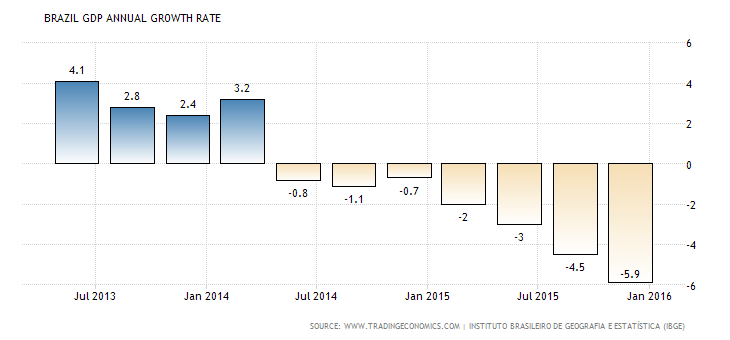
Figure 1.
The main cause for the contraction was the drop in consumption and investment. Nonetheless, if the whole year of 2015 is considered, then it is clear that the Gross Domestic Product of Brazil shrank by 3.8% and the annual GDP growth from 1991 to 2015 has been at an average of 2.87% (Trading Economics, 2016).
Table 2
| Year | Economic Growth (GDP annual Variation %) |
| Year 2011 | 3.9 |
| Year 2012 | 1.9 |
| Year 2013 | 3 |
| Year 2014 | 0.1 |
| Year 2015 | -3.8 |
The graphic of the above fall is illustrated in the chart below.
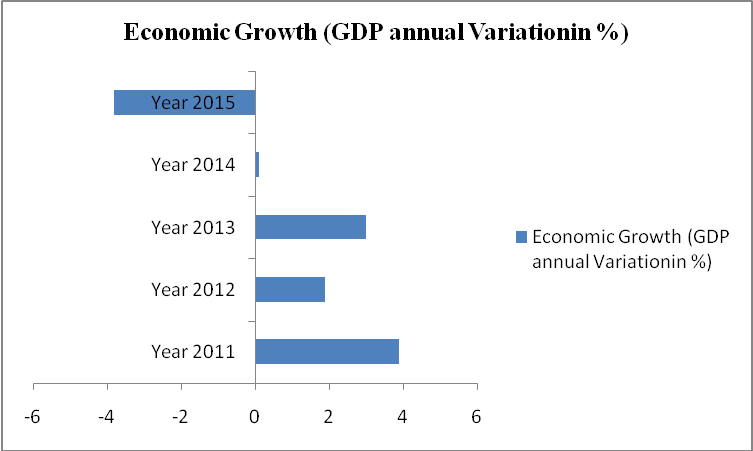
Figure 2.
Finally, major sectors of the economy such as banking, telecommunication, commerce, and energy accounted for approximately 15% of the GDP in 2015 (Trading Economics, 2016). Agriculture contributes 6% of the GDP per year and has been revealed to employ around 20% of the labor force in Brazil (TradingEconomics,2016).
Unemployment Rate
The term unemployment can often be described in simple words as the number of people within a given area who do not have jobs, but are willing and have the ability to work. The rate of unemployment in Brazil has been on the increase in the last five years. The countrys unemployment rate, which was non-seasonally adjusted, rose to around 8.2% in the first quarter of 2016 (Trading Economics, 2016).
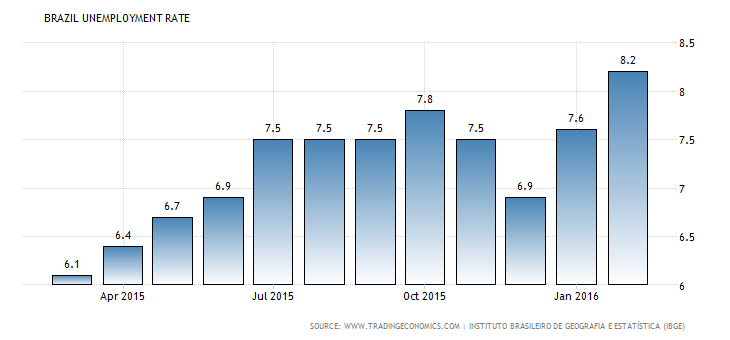
Figure 3.
The previous year of 2015 saw the rate at the level of 6.83%, which was an increase by 1.99% from 2014. However, the drop between 2013 and 2014 was seasonal and was mainly caused by a high number of stores and companies within the country that were hiring many workers in advance for the end-of-the-year holidays (Trading Economics, 2016). An increase in the rate of unemployment can also be attributed to the economic and political crisis (recession) in Brazil that has adversely affected major industries in the country such as automobile, oil, and construction sectors, as well as affecting most companies that depend on these sectors, thus leading to a major layoff of workers. The trend in the countrys unemployment rate in the last five years is further illustrated in the below table and chart.
Table 3
| Year | Unemployment Rate (%) |
| Year 2011 | 5.97 |
| Year 2012 | 5.48 |
| Year 2013 | 5.39 |
| Year 2014 | 4.84 |
| Year 2015 | 6.83 |
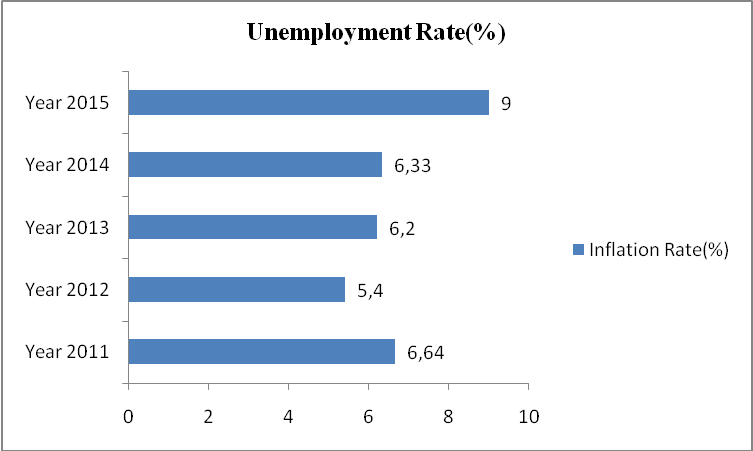
Figure 4.
The trend in the rate of unemployment has further been predicted to increase with economists forecasting the countrys unemployment rate to be at the level of 10.04% by 2020.
Inflation Rate
The rate of inflation has continued increasing in Brazil over the last five years. The consumer price inflation has continued increasing despite the economic contract that the country currently undergoes. In 2015, the countrys inflation rate hit its highest level of 13%, which was the highest level since 2002 when the inflation was at 12.53% (Trading Economics, 2016).The countrys tolerance band was evident in 2002 and 2003. The Brazilian central banks target for inflation in 2015 was 4.5% and the preset tolerance band was set at the level between 2.5 to 6.5% (Trading Economics, 2016). However, the countrys core rate of inflation increased to 7.95% in the first quarter of 2016. From 2010 to 2016, the rate of inflation in Brazil has been at an average level of 6.43% and has reached an all-time high rate of 9.45% in 2015 (Trading Economics, 2016). The inflation rate hit a record low rate of 4.85% in 2010.
Table 4
| Year | Inflation Rate (%) |
| Year 2011 | 6.64 |
| Year 2012 | 5.4 |
| Year 2013 | 6.2 |
| Year 2014 | 6.33 |
| Year 2015 | 9 |
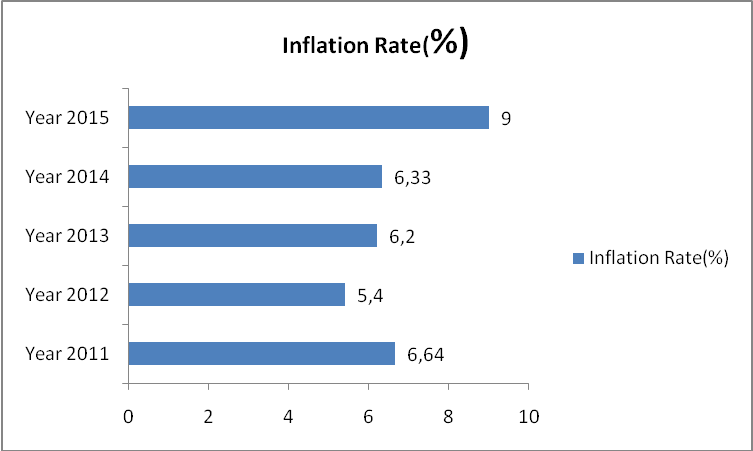
Figure 5.
It is important to note further that the inflation rate in Brazil tracks price changes in a consumer-to-purchase basket and excludes certain prices that are volatile.
Gross National Product
The GNP is often defined by economists as the total value of services provided and goods produced by a given country in a given year (Mielnik & Goldemberg, 2002). The indicator is measured by adding expenditure on consumption, government expenditure, overseas investment, minus income earned by foreign residents within the domestic economy. Brazils GNP increased from 1,446,839.04 in the third quarter of 2015 to 1,489,781.98 BR million in the fourth quarter of the same year. On average, the countrys GNP has been at the level of 773,422.05 BR million from 2000 to 2015.
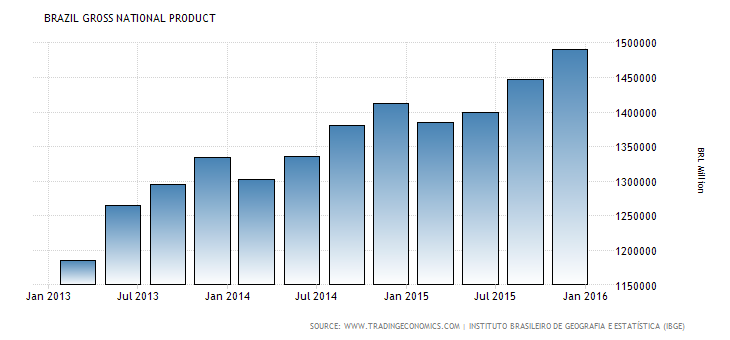
Figure 6.
Social Indicators
Education Measures
Regarding education, the country has made a huge improvement towards the reduction of illiteracy. The effort has seen the country reduce the illiteracy level from 16.3 million in 2000 to 13.2 million in 2012. However, the reduction stagnated in 2013 due to ineffectiveness caused by Bolsa Familia, which the government heavily relied on. The main issue the country faces due to a poorly designed public education system is that approximately 18% of the countrys population are functionally illiterate (Trading Economics, 2016). It means that they only know numbers and words, but cannot comprehend sentences. The countrys government has launched several aggressive measures to boost the countrys educational system performance. Some of the measures include aims to increase the number of years for mandatory education .The country intends to double investment in education and in 2012 it channeled 5.3% of the countrys GDP into education with an aim to increase it to 10% in 2014 (Trading Economics, 2016).
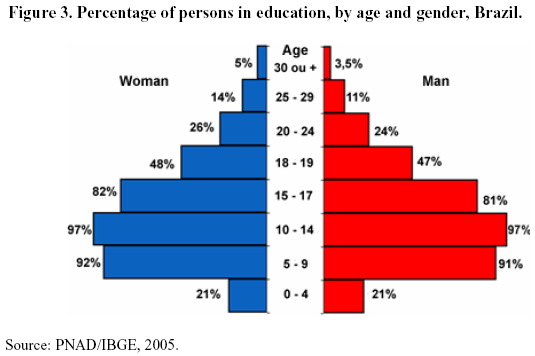
Figure 7.
From the above chart, it is clear that the number of children that enroll for education is higher today than in the past, but it drastically drops as they approach adulthood for both genders.
Health Measures
Brazil as a country currently faces health problems. According to the government, some serious problems that the country encounters concern childhood mortality, motherhood mortality, and mortality that is caused by a non-transmissible illness. According to the government data, the childhood mortality is at the level of about 2.51%, while there are approximately 73.1 deaths per 100,000 children (Trading Economics, 2016). The countrys life expectancy increased from 69.66 years in 1998 to approximately 74.6 years in 2012. Health of a child is still one of the major issues in any developing country. Brazil has however initiated various policies that have seen a decline in the infant mortality, but the rate remains high when compared to international standards (Pickett & Wilkinson, 2015). The table below shows the trend of infant mortality over the last five years.
Table 5
| Country | 2011 | 2012 | 2013 | 2014 | 2015 |
| Brazil | 14 | 14 | 14 | 14 | 15 |
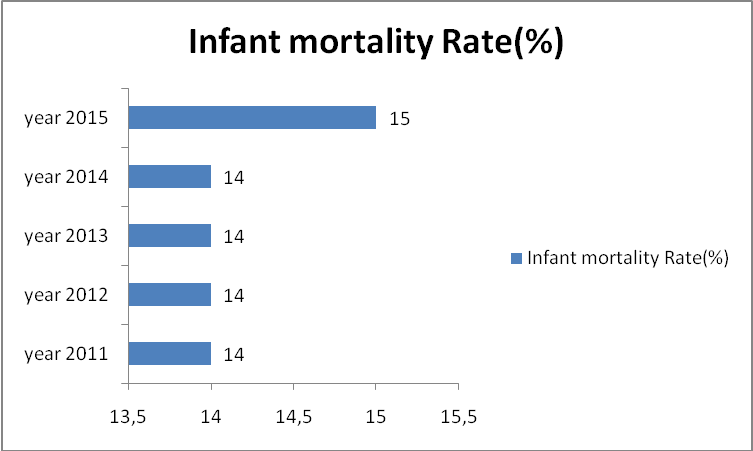
Figure 8.
The rate has been constant at the level of 14% over the years with a slight increase in 2015 due to the prevalent economic crisis that affected the health sector.
Income Distribution
Brazil is one of the most unequal countries in the world regarding income distribution. Excessive income inequality in the country has led to adverse effects on economic growth, social cohesion, crime, and health outcomes. Excessive income inequality is caused mainly by less equitable education distribution, regressive public transfers, and high wage differentials. In Brazil, approximately 10% of the population lives on less than $1.3 a day, which is far below the poverty line that is set by the government (De Barros, Corseuil, Mendon?a, & Reis, 2015). Minimum wage of the country is currently $335 a month. In 2012, the income value share that was held by the countrys second 20% was at the level of 7.65, which was the maximum, while the minimum value was seen in 1989 (De Barros et al., 2015).
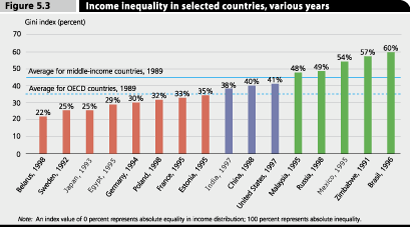
Figure 9.
Brazil income distribution is still high. In 1996, the countrys income inequality was at the level of 60%, which was the highest level ever achieved by any country (Pickett & Wilkinson, 2015).
Poverty
Poverty in the country is usually represented by visible slums known as favelas that are common in the metropolitan area and other remote parts of the upcountry regions. Reports have however indicated that poverty remarkably dropped from 31% in 2003 to 21% in 2009 and the fall was predicted to continue in a downward trend in the upcoming years (De Barros et al., 2015).
Table 6
| Country | year 1990 | year 1998 | year 2005 | year 2008 | year 2009 | year 2013 | year 2014 |
| Brazil | 1.4 | 22 | 31 | 26 | 21.4 | 21.4 | 21.4 |
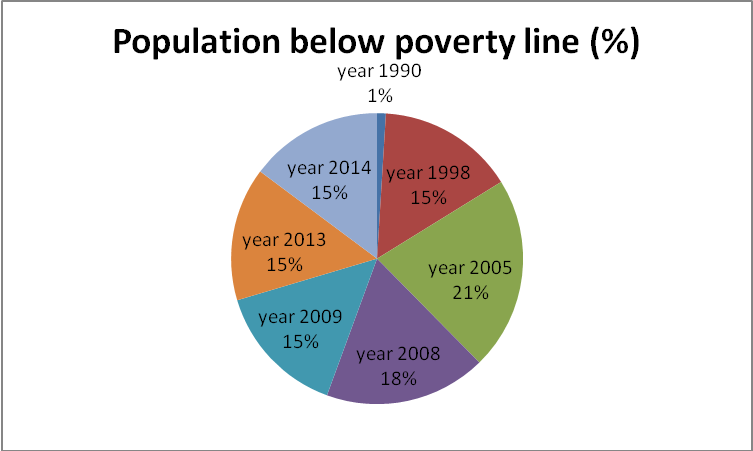
Figure 10.
The recent data show that 4.2% of the countrys total population lived below the poverty line in 2014 (De Barros et al., 2015).
Global Market Integration
The term global market differentiation defines the process through which different countries combine different activities all over the world with an aim of operating while using the same method. In terms of global market integration, the country has assumed a prominent role in global trade and energy issues in the last five years (Braga & Tyler, 2015). Success evident from the countrys rapid growth in the global market has been mainly caused by its export and import activities.
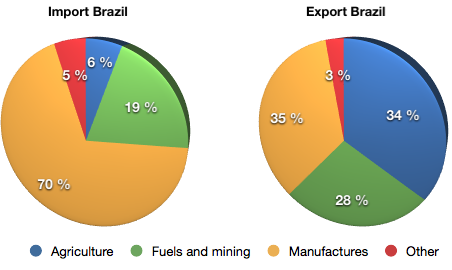
Figure 11.
Export
The countrys major economic growth has largely been attributed to exports in both industrial sector and agriculture. The country is the worlds biggest exporter of chicken, sugar, beef, and coffee. In March of 2016, the countrys export fell by 5.8% to $15.99 billion (Trading Economics, 2016). Brazils exports have averaged $4,418.06 million between 1954 and 2016. The countrys export was the highest in 2011 at $26,158.51 million, while it was the lowest in 1965 at $75.06 million (Trading Economics, 2016). The countrys top exports to the global market include oil seeds, which make up 11% of the countrys total export. Oil forms 7.2% of the countrys total export, while meat and machinery form 6.8% and 5.9% of the countrys total export respectively (Braga & Tyler, 2015). The country shipped approximately $191.3 billion worth of goods into the global market in 2015, which was down by around 25% from 2011 and drastically dropped by 15% from 2014 to 2015. Some of the countrys main global export markets include China, the USA, Argentina, and Germany (Trading Economics, 2016).
Imports
Brazil is not one of the major importers of commodities, but it still imports certain products for domestic consumption. In the last five years, approximately 20% of products consumed by the country have been imported, meaning that one out of every five products that has been consumed in the country during this period has been imported. The countrys imports has contracted by 30% in 2016 to 11.6 billion, while its highest level was in 2013 at $23,050.46 (Trading Economics, 2016). The countrys crude oil forms 6.2% of the countrys import and the state company has been striving to increase oil imports because the countrys refineries have ben processing a higher volume of the given commodity than the volume it can produce. Furthermore, import of gas is often substituted with crude oil purchase, which represents raw materials. The country also imports automobiles, which form 5.3% of the countrys import (Trading Economics, 2016). The country has imported around 913 cars in 2016. Most imported cars come from Argentina, Korea, and Mexico. Brazils main supplier of auto parts is Mexico. This import forms 2.8% of the total countrys import (Trading Economics, 2016). The import of auto parts was increased by 87% in 2010, which translated into $287 million and $381 million in 2011. Finally; the country depends mostly on imported drugs and medicine, which forms 2.6% of the countrys total imports.

 Top 10 writers
Top 10 writers

Your order will be assigned to the most experienced writer in the relevant discipline. The highly demanded expert, one of our top-10 writers with the highest rate among the highest rate among the customers.
Hire a TOP WriterIn terms of production, Brazils food production is centered on agriculture, particularly on sugarcane production. 31% of the country is used as cropland to produce sugarcane, coffee corn, and soya beans. Brazil produces over 600 million tons of sugarcane every year. The country also ranks second in the world in terms of beef production. In 2014, production of grain was approximately 145.4 million tons. Being a major exporter of most agricultural products, the country has been hit significantly by the global food price volatility, which has seen prices of major food commodities reach maximum highs. In 2015, the price of red fruit rose by 122%, which led to major tomato trafficking from Argentina, hence causing an outrage in the country (Trading Economics, 2016). The country has further requested the G20 members to take measures that could address the issue of food price volatility.
You will receive these EXTRAS at no additional charge ($57.30)
- FREE Plagiarism Report Screenshot (on request)
- FREE Bibliography / Reference Page
- FREE Revision within 2 days (48 hours)
- FREE E-mail Delivery
 FREE Formatting
FREE Formatting- FREE Outline
Relationship with Global Organizations
As one of the major players in the global market in terms of export and import, Brazil has managed to integrate itself as a member of various global organizations, including both economic and financial organizations. The country is a member of several economic organizations such as the FTAA (Free Trade Area of the Americas) and Inter-American Development Bank, which focuses on economic integration with respect to diversity and reduction of regional inequality. Besides, the country is a member of the G-20, IADB, and World Trade Organization. The country is also a member of such financial organizations as the IMF and the World Bank.
The countrys relationship with the IMF can be said to have developed from that of a debtor to a major creditor. However, for the first time in six years the country has made a decision not to renew its agreement with the IMF since the government considers the institution as the major cause of economic failure in the country. From 1998 to the present, the country has withdrawn $93 billion from its IMF credit line and it owed the institution a total of $24.6 billion dollars at the end of 2011 (Canuto, Fleischhaker, & Schellekens, 2015). Regarding the World Bank, the country is a huge beneficiary of its programs since the WB currently plays a major role in ensuring success of integration between Sub-Saharan Africa and Brazil. Between 2011 and 2015, Brazils major debts to the World Bank stood at $55,687,115,700 (Canuto et al., 2015). The country has recently filed a trade suit against Thailand and Indonesia. The first case concerns measures that are used by Indonesia to bovine beef that has been imported from Brazil, while the other dispute concerns subsidies that the government of Thailand has provided to the Brazilian sugar sector.
Your academic success is just in a few clicks!
Start nowSocial Problems
Even though Brazil is on top of its advancement in the economy, the country still faces a myriad of social problems. Poverty is a social problem that continues rocking the country. The rate of poverty and social inequality in Brazil is high with millions of people living in poverty in the country. Numerous slums around cities are a major testimony of the level of poverty in the country. Unemployment is another social problem that the country faces with millions of Brazilians still being without jobs. Finally, the rate of crime and violence is high in the country with the rates being blamed on the high level of poverty and unemployment in the country.
Conclusion
Brazil is one of the underdeveloped countries in the world, but it has acquired the status of a rapidly developing country, especially in the South American region. The countrys major economic indicators, however, show mixed trends and patterns with major indicators such as the GDP showing an improving economy. In turn, other indicators such as the inflation rate, which has remained high over the years, indicate threats faced by the country in its economic undertakings. On the global market, the country is a major exporter of agricultural and industrial products, while importing various products, including medicine and drugs. Brazil is a member of various organizations such as the IMF, the WTO, and the World Bank, which has strengthened its economic position and provided financial assistance to the country. Finally, such major issues as crime, unemployment, and poverty are among topical social challenges that continue affecting the country.
January 11, 2021
Share





 FREE
FREE 






